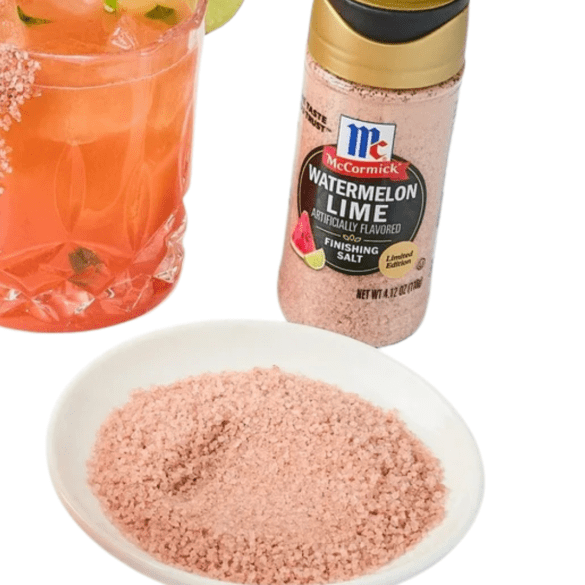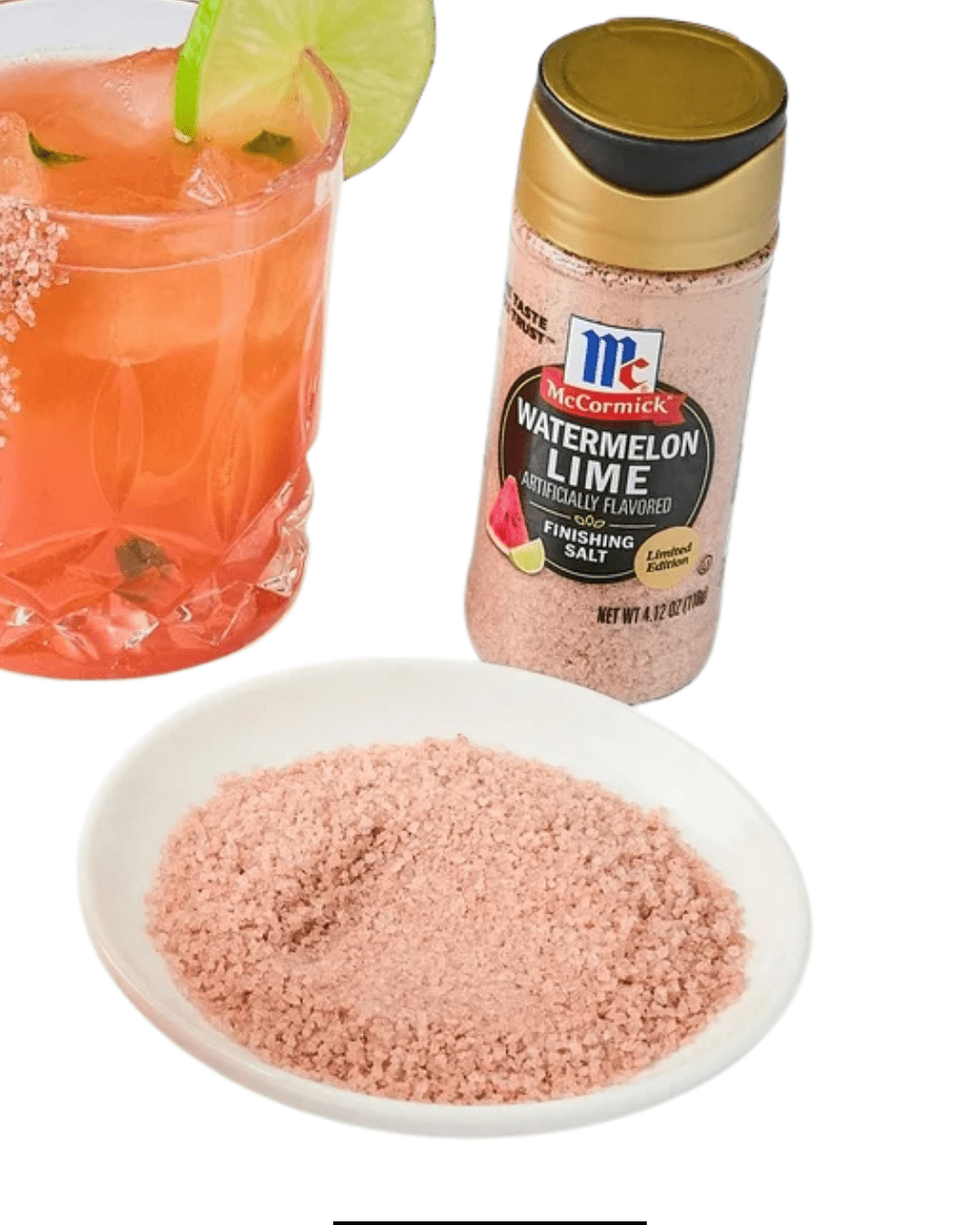McCormick Watermelon Lime Salt is a vibrant blend of tangy lime, sweet watermelon, and coarse salt—like a flavor party in a bottle! It’s perfect for summer recipes, creative kitchen experiments, or even adding a fun twist to everyday favorites.
Table of Contents
How to make McCormick Watermelon Lime Salt
McCormick® Watermelon Lime Finishing Salt is a limited-edition, coarse-grain seasoning that combines the sweetness of watermelon with the tanginess of lime, creating a vibrant and fruity flavor profile.
Ingredients
- Coarse Sea Salt (or Himalayan salt) – About ½ cup
- Watermelon Powder – 1–2 tablespoons
- Lime Zest – Zest from 2 limes
- Lime Juice – About 1–2 teaspoons (optional)
- Sugar (optional) – 1 teaspoon
Instructions
Step 1: Create Watermelon Powder
- Thinly slice fresh watermelon (or use pre-dried watermelon).
- Place the slices in a dehydrator or bake them at a very low heat (around 170°F or 76°C) for 6–8 hours until fully dried.
- Once dried, grind the watermelon slices into a fine powder using a food processor or spice grinder.
Step 2: Prep Lime Zest
- Wash and dry two limes.
- Use a microplane or zester to scrape the lime peel (avoid the bitter white pith).
Step 3: Combine Ingredients
- In a small mixing bowl, combine the coarse sea salt, watermelon powder, lime zest, and lime juice (if using).
- Stir everything together until well incorporated. Adjust the proportions of watermelon and lime to your taste.
Step 4: Spread & Dry
- Spread the mixture on a parchment-lined baking sheet.
- Let it air dry for several hours or place the sheet in a low-temperature oven (around 175°F or 80°C) for 15–20 minutes to ensure the mixture dries completely.
Step 5: Store
- Once dry, store your homemade Watermelon Lime Salt in an airtight container or jar. If kept in a cool, dry place, it’ll last for weeks.
Tips for Creating the Perfect Watermelon Lime Salt
- Texture Matters: If the salt feels too coarse, pulse it briefly in a food processor to get a slightly finer texture — but don’t overdo it! You want those chunky crystals.
- Flavor Balance: If the watermelon flavor is too light, add a bit more powder. Taste as you go and tweak proportions to suit your taste.
- Uses: Sprinkle your homemade seasoning on fresh fruit, rim cocktail glasses, season grilled fish, or experiment with desserts like sorbet for that extra zing.
- Experiment with Variations: Try adding a pinch of chili powder for a spicy punch or swap lime zest for lemon zest for a different citrus profile.
What to serve with
McCormick Watermelon Lime Salt is a bold and flavorful seasoning that enhances sweet, savory, and tangy dishes. From fresh fruits to cocktails, its versatility allows you to explore endless possibilities.
1. Fresh Fruits
McCormick Watermelon Lime Salt is perfectly designed to complement fresh, juicy fruits. Its tangy and sweet profile enhances the natural sweetness while adding an unexpected zing. Here’s what pairs best:
- Watermelon: Slice up some chilled watermelon, sprinkle the salt generously, and let the flavors sing.
- Pineapple: The tropical sweetness of pineapple contrasts beautifully with the lime’s acidity and saltiness.
- Mango: A flavorful sprinkle brings out the richness of perfectly ripe mango.
- Cucumber: Lighter fruits like cucumber benefit from the salty-tangy upgrade.
2. Cocktails & Beverages
This seasoning works wonders as a cocktail rim salt, adding complex layers to your favorite drinks. Try it with:
- Margaritas: Ditch standard rim salt and use Watermelon Lime Salt on the rim to give your margarita a fruity twist.
- Palomas: The citrus notes in the salt elevate tequila-based drinks with grapefruit juice.
- Mocktails: For non-alcoholic options, try pairing it with iced sparkling water, lime soda, or virgin mojitos to make every sip exciting.
3. Savory Snacks
Surprisingly, this salt adds depth to savory snacks by providing a balance of sweet and tangy alongside the saltiness. Perfect for:
- Popcorn: Sprinkle it over fresh popcorn for a gourmet twist.
- Roasted Nuts: Toss your favorite roasted nuts—almonds, cashews, or peanuts—with a sprinkle for added flavor.
- Corn on the Cob: For a tangy finish, boost your grilled corn with butter and Watermelon Lime Salt.
Ingredients Substitutes
McCormick Watermelon Lime Salt is a unique flavor blend typically used as a seasoning or rimmer for beverages like margaritas or micheladas, or as a topping for fresh fruits and snacks. If you’re looking to recreate or substitute some of the ingredients for this seasoning, here’s a detailed guide to alternatives and substitutes:
1. Watermelon Flavor
Watermelon provides the signature sweetness and fruity component of this seasoning blend. To mimic it:
Substitute Ideas:
- Watermelon Powder: If available, watermelon powder can mimic the taste. This can be made by dehydrating watermelon slices and grinding them into powder.
- Watermelon Juice Reduction: Reduce fresh watermelon juice to a concentrated syrup, then dry it into small granules or mix with the salt.
- Artificial Watermelon Flavoring: Candy or drink flavor extracts can be used sparingly for a watermelon-like taste.
- Fruit Substitute: Use other sweet and fruity powders like strawberry or raspberry.
2. Lime Flavor
Lime contributes a tangy, citrusy kick that balances the sweetness of watermelon.
Substitute Ideas:
- Lime Zest: Fresh lime zest is an excellent substitute. Dry the zest and mix it with salt to intensify the lime flavor.
- Citric Acid: Food-grade citric acid can mimic the tangy lime flavor. Use sparingly as it is highly concentrated.
- Lemon Zest or Powder: Lemon zest is a suitable alternative, though it’s slightly less tangy than lime.
- Lime Powder: If the lime powder is unavailable, ground-dried lime can replace it.
3. Salt
Salt is the foundation of this seasoning, enhancing the other flavors and providing the desired savoriness.
Substitute Ideas:
- Sea Salt: A more natural and coarser substitute for table salt.
- Himalayan Pink Salt: Offers a unique mineral flavor and lighter saltiness.
- Kosher Salt: Coarse-textured and less overpowering in flavor compared to traditional table salt.
- Low-Sodium Alternatives: If you’re looking for a healthier substitute, low-sodium salts can be used.
4. Sugar
Though not a declared ingredient, watermelon lime salt likely has some sweetness to balance the saltiness.
Substitute Ideas:
- Coconut Sugar: A natural alternative with a hint of caramel flavor.
- Stevia or Monk Fruit: Sugar substitutes for a low-calorie option.
- Brown Sugar: Adds depth of flavor but might slightly alter the color.
- Powdered Sweetener: Granulated or powdered sweeteners mix better with salt for an even texture.
Final Thoughts
McCormick Watermelon Lime Salt is truly a seasoning superstar that can elevate almost any dish or drink. From refreshing fruits to bold cocktails and savory bites, it’s the perfect blend of sweetness, tanginess, and saltiness to brighten your culinary creations.

Ingredients
- Coarse Sea Salt– About ½ cup
- Watermelon Powder – 1–2 tablespoons
- Lime Zest – Zest from 2 limes
- Lime Juice – About 1–2 teaspoons (optional)
- Sugar (optional) – 1 teaspoon
Instructions
Step 1: Create Watermelon Powder
- Thinly slice fresh watermelon (or use pre-dried watermelon).
- Place the slices in a dehydrator or bake them at a very low heat (around 170°F or 76°C) for 6–8 hours until fully dried.
- Once dried, grind the watermelon slices into a fine powder using a food processor or spice grinder.
Step 2: Prep Lime Zest
- Wash and dry two limes.
- Use a microplane or zester to scrape the lime peel (avoid the bitter white pith).
Step 3: Combine Ingredients
- In a small mixing bowl, combine the coarse sea salt, watermelon powder, lime zest, and lime juice (if using).
- Stir everything together until well incorporated. Adjust the proportions of watermelon and lime to your taste.
Step 4: Spread & Dry
- Spread the mixture on a parchment-lined baking sheet.
- Let it air dry for several hours or place the sheet in a low-temperature oven (around 175°F or 80°C) for 15–20 minutes to ensure the mixture dries completely.
Step 5: Store
- Once dry, store your homemade Watermelon Lime Salt in an airtight container or jar. If kept in a cool, dry place, it'll last for weeks.
